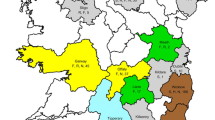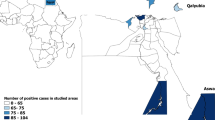Abstract
Serum samples from 210 wild ruminants collected between 2006 and 2007 in southern Spain were tested for antibodies against bluetongue virus (BTV) by means of a competitive ELISA assay. Eighty-seven of the 210 wild ruminants analysed (41%) showed antibodies against BTV. Statistically significant differences were found in the seroprevalence among species: 66% (65 of 98) for red deer (Cervus elaphus), 50% (ten of 20) for fallow deer (Dama dama), 33% (three of nine) for mouflon (Ovis aries musimon) and 11% (nine of 83) for Spanish ibex (Capra pyrenaica). Overall, the sites where seropositive wild ruminants were found coincide with the areas where BTV had been detected in livestock, but in eastern Sierra Morena, the virus circulated in wild ruminants, although it had not been detected in domestic ruminants in the same areas. Wild ruminants over 1-year of age (sub-adults and adults) had significantly higher seroprevalences than juvenile animals. Statistically significant differences were also observed between BTV seroprevalence and management (free-ranging vs. captivity) with higher prevalence in free-ranging animals. The high seroprevalences obtained suggest that BTV is widespread in wild ruminants in southern Spain. This factor could have an important influence on the evolution of the infection in domestic livestock and indicates the need to include wild ruminant species in BTV surveillance or control programs.

Similar content being viewed by others
References
Aguirre AA, Hansena DE, Starkeyb EE, McLean RG (1995) Serologic survey of wild cervids for potential disease agents in selected national parks in the United States. Prev Vet Med 21:313–322. doi:10.1016/0167-5877(94)00386-W
Anonymous (2007) European Food Safety Authority (EFSA). Scientific Report of the Scientific Panel on Animal Health and Welfare on request from the Commission (EFSA-Q-2006-311) and EFSA selfmandate (EFSA-Q-2007-063) on bluetongue. Adopted by the AHAW panel on 27 April 2007 The EFSA Journal 480: 1–20
Anonymous (2008) Ministerio de Agricultura Pesca y Alimentación (MAPYA). Url: http://www.rasve.mapa.es/Publica/Focos/Focos_Consultar.asp. Accessed May 5, 2008
Bender LC, Li H, Thomson BC, Morrow PC, Valdez R (2003) Infectious disease survey of Gemsbok in New Mexico. J Wildl Dis 39:772–778
Böhm M, White PCL, Chambers J, Smith L, Hutchings MR (2007) Wild deer as a source of infection for livestock and humans in the UK. Vet J 174:260–276. doi:10.1016/j.tvjl.2006.11.003
Calvete C, Miranda MA, Estrada R, Borràs D, Sarto i Monteys V, Collantes F, García de Francisco JM, Moreno N, Lucientes J (2006) Spatial distribution of Culicoides imicola, the main vector of bluetongue virus, in Spain. Vet Rec 158:130–131
De Curtis M, Bartolini C, Canonico C, Duranti A, Leoni F, Mancini P, Moscatelli F, Rocchegiani E, Gavaudan S (2006) Serological monitoring of bluetongue virus in wild ruminants of the Pesaro-Urbino district (Italy). Webzine Sanita Pubblica Veterinaria, 40. Febbraio 2006:3.
Du C (1996) An interpolation method for grid-based terrain modelling. Comput J 39(10):837–843. doi:10.1093/comjnl/39.10.837
Fernández-Pacheco P, Férnandez-Pinero J, Agüero M, Jiménez-Clavero MA (2008) Bluetongue virus serotype 1 in wild mouflons in Spain. Vet Rec 162:659–660
Formenty P, Domenech J, Lauginie F, Ouattara M, Diawara S, Raath JP, Grobler D, Leforban Y, Angba A (1994) Epidemiologic study of bluetongue in sheep, cattle and different species of wild animals in the Ivory Coast. OIE Sci Tech Rev 13(3):737–751
Frölich K, Thiede S, Kozikowski T, Jakob W (2002) A review of mutual transmission of important infectious diseases between livestock and wildlife in Europe. Domestic animal/wildlife interface: issue for disease control, conservation, sustainable food production, and emerging diseases. Ann N Y Acad Sci 969:4–13
Frölich K, Hamblin C, Jung S, Ostrowski S, Mwanzia J, Streich WJ, Anderson J, Armstrong RM, Anajariyah S (2005) Serologic surveillance for selected viral agents in captive and free-ranging populations of Arabian Oryx (Oryx Leucoryx) from Saudi Arabia and the United Arab Emirates. J Wildl Dis 46:67–79
Gortázar C, Acevedo P, Ruiz-Fons F, Vicente J (2006) Disease risk and overabundance of game species. Eur J Wildl Res 52:81–87. doi:10.1007/s10344-005-0022-2
Gortázar C, Ferroglio E, Höfle U, Frölich K, Vicente J (2007) Diseases shared between wildlife and livestock: a European perspective. Eur J Wildl Res 53:241–256. doi:10.1007/s10344-007-0098-y
Gür S (2008) A serologic investigation of blue tongue virus (BTV) in cattle, sheep and gazella subgutturosa subgutturosa in outheastern Turkey. Trop Anim Health Prod 40:217–221. doi:10.1007/s11250-007-9083-4
Henrich M, Rainacher M, Hamann HP (2007) Lethal bluetongue virus infection in an alpaca. Vet Rec 1:764
Hoff GL, Trainer DO (1978) Bluetongue and epizootic haemorrhagic disease viruses: their relationship to wildlife species. Adv Vet Sci Comp Med 22:111–129
Johnson DJ, Ostlund EN, Stallknecht DE, Goekjian VH, Jenkins-Moore M, Harris SC (2006) First report of bluetongue virus serotype 1 isolated from a white-tailed deer in the United States. J Vet Diagn Invest 18:398–401
Linden A, Mousset B, Grégorie F, Hanrez D (2008) Bluetongue virus antibodies in wild red deer in southern Belgium. Vet Rec 5:459
Lopez AC, Sánchez-Botija C (1958) Epizootie de fièvre catarrhale ovine en Espagne (blue tongue). Bullettin Off Int Epizooties 50:65–93
MacLachlan NJ (2004) Bluetongue: pathogenesis and duration of viraemia. Vet Ital 40:462–467
Mellor PS, Wittmann EJ (2002) Bluetongue virus in the Mediterranean basin, 1998–2001. Vet J 164:20–37. doi:10.1053/tvjl.2002.0713
Mertens PP, Diprose J, Maan S, Singh KP, Attoui H, Samuel AR (2004) Bluetongue virus replication, molecular and structural biology. Vet Ital 40:426–437
OIE. World Organisation for Animal Health (2004) Bluetongue in Spain: serological findings in the peninsular territory, in sentinel animals. Dis Inf 17:302, 15 October
Rivera H, Madewell B, Ameghino E (1987) Serologic survey of viral antibodies in the Peruvian alpaca (Lama pacos). Am J Vet Res 48:189–191
Ruiz-Fons F, Reyes-García AR, Alcaide V, Gortázar C (2008) Spatial and temporal evolution of bluetongue virus in wild ruminants, Spain. Emerg Infect Dis 14(6):951–953
Saenz de Buruaga M, Lucio AJ, Purroy J (1991) Reconocimiento de sexo y edad en especies cinegéticas. Diputación Foral de Álava, Spain, Vitoria-Gasteiz
Schwartz-Cornil I, Mertens PP, Contreras V, Hemati B, Pascale F, Bréard E, Mellor PS, MacLachlan NJ, Zientara S (2002) Bluetongue virus: virology, pathogenesis and immunity. Vet Res 39(5):46–61
Stallknecht DE, Howerth EW (2004) Epidemiology of bluetongue and epizootic haemorrhagic disease in wildlife: surveillance methods. Vet Ital 40(3):203–207
Thiry E, Saegerman C, Guyot H, Kirten P, Losson B, Rollin F, Bodmer M, Czaplicki G, Toussaint JF, De Clercq K, Dochy JM, Dufey J, Gilleman JL, Messeman K (2006) Bluetongue in northern Europe. Vet Rec 159(10):327
Ward MP, Carpenter TE, Osburn BI (1994) Host factors affecting seroprevalence of bluetongue virus infections of cattle. Am J Vet Res 55(7):916–920
Acknowledgements
We gratefully acknowledge the support from the hunting authorities, the RAC Serranía de Ronda, RAC Cortes, hunters and gamekeepers for the collection of samples. This study was supported by project P05-AGR00132, Consejería de Innovación, Ciencia y Empresa, Junta de Andalucía.
Author information
Authors and Affiliations
Corresponding author
Additional information
Communicated by C. Gortázar
Electronic supplementary material
Below is the link to the electronic supplementary material
ESM 1
(PDF 182 KB)
Rights and permissions
About this article
Cite this article
García, I., Napp, S., Casal, J. et al. Bluetongue epidemiology in wild ruminants from Southern Spain. Eur J Wildl Res 55, 173–178 (2009). https://doi.org/10.1007/s10344-008-0231-6
Received:
Revised:
Accepted:
Published:
Issue Date:
DOI: https://doi.org/10.1007/s10344-008-0231-6




